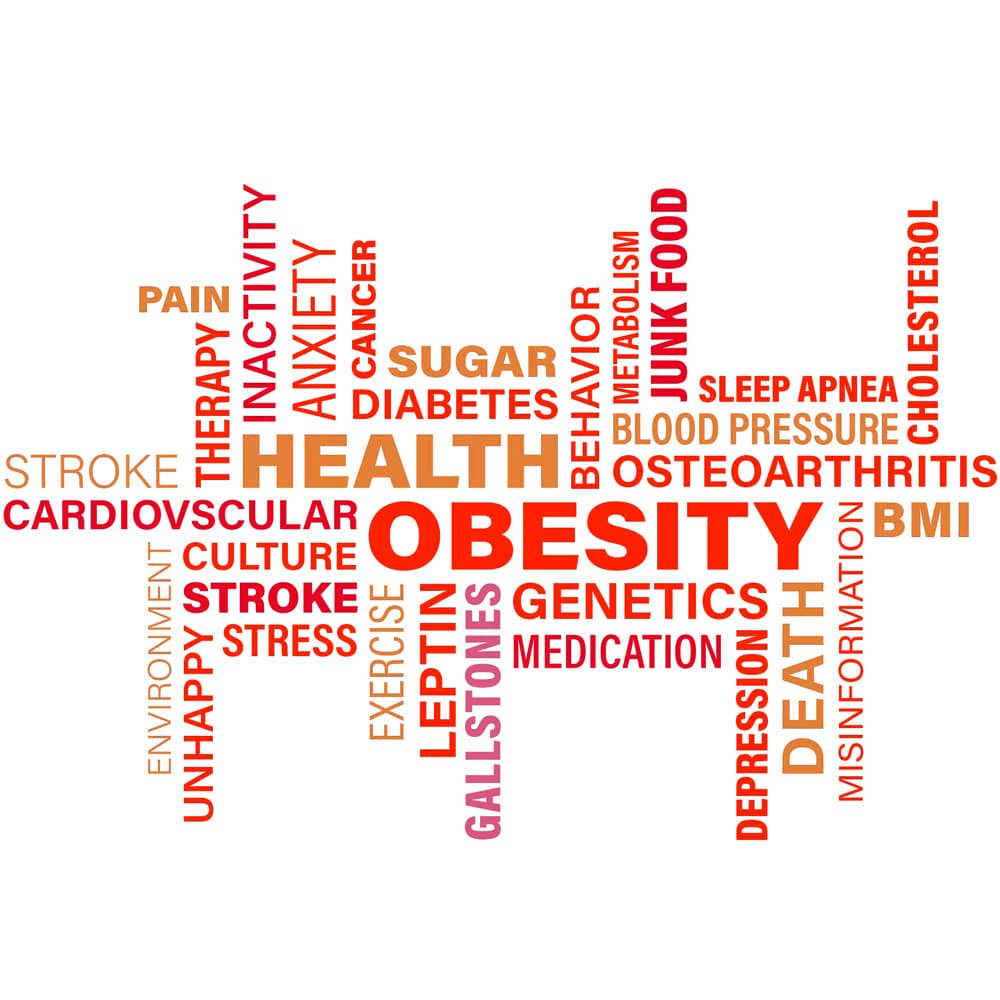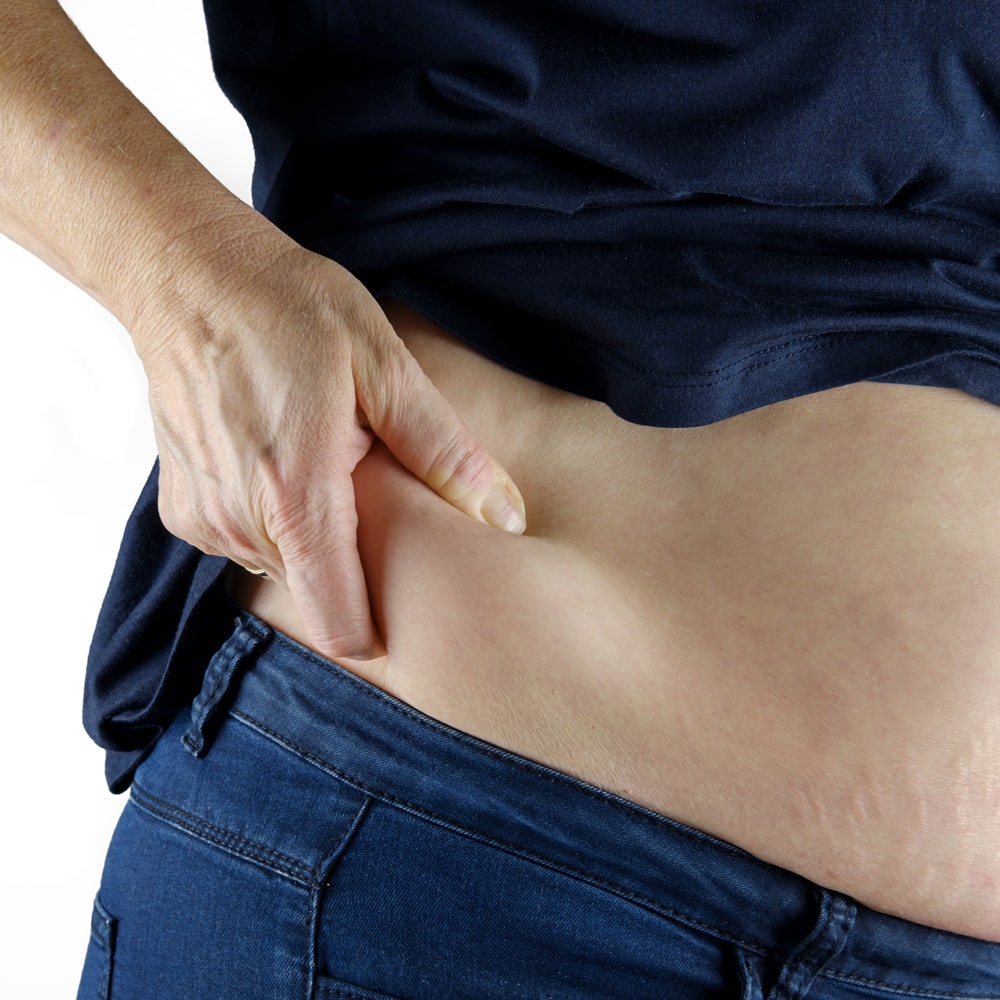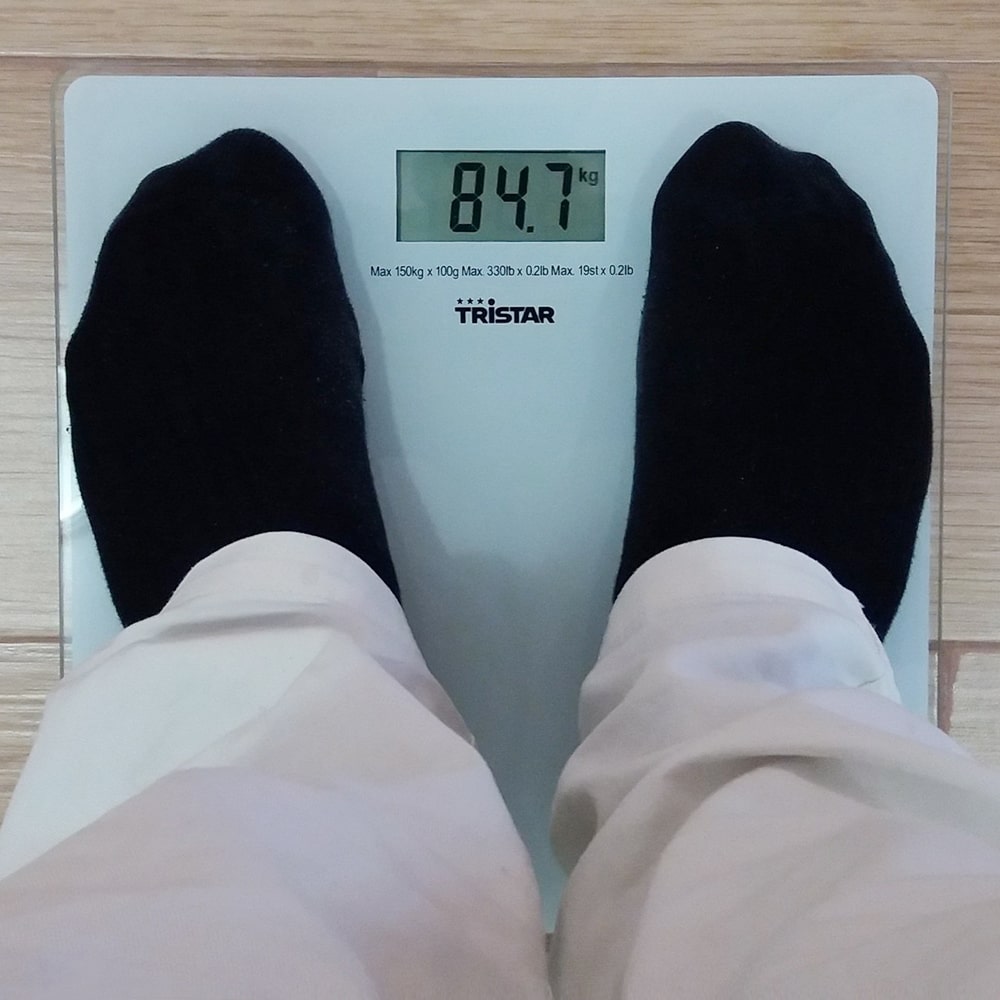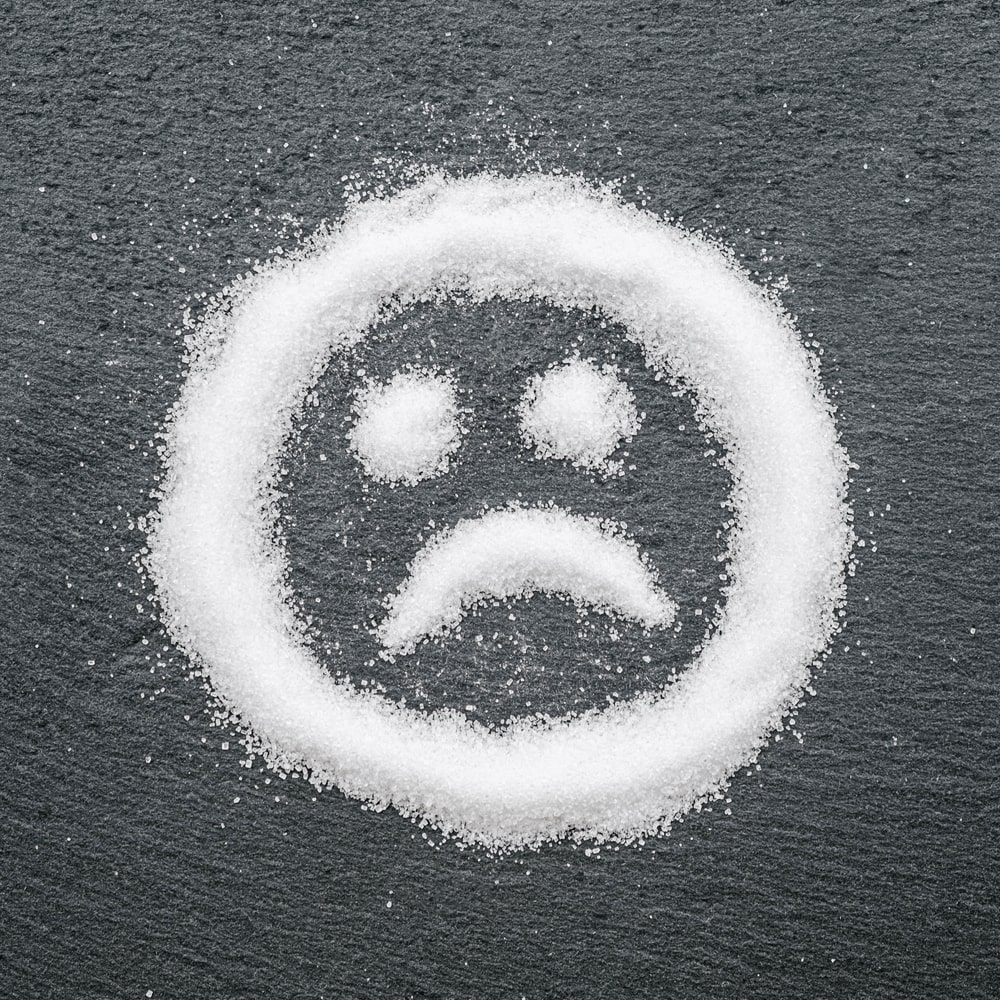
Obesity
Obesity is overweight that is detrimental to health. Usually, this type of disease is associated with many secondary diseases and a particularly limited quality of life. In many cases, however, it is not only the disease itself that burdens those affected, but also the increasing stigmatisation by society. Here you can read the most important information about obesity and how to deal with it.

Obesity
Obesity: A brief summary
- What is obesity? It is a chronic, morbid obesity. Obesity is defined as having a BMI of at least 30.
- Symptoms: generally extreme accumulation of fat in the body, often associated with shortness of breath, reduced performance and excessive sweating.
- Possible secondary diseases: Fatty liver, cardiovascular diseases, diabetes, back problems, gout, psychological problems, joint problems, various cancers and kidney stones.
- Possible causes: unhealthy diet, slow metabolism, various pre-existing diseases, lack of exercise and genetic predispositions
- Therapy/treatment: Exercise, behavioural or nutritional therapy, various medications up to stomach reduction
- Future prognosis: difficult to treat, often shortened life span and a high risk of further diseases

Obesity Overweight Abdominal Girth.
What is obesity?
Many people think of obesity as a figure problem. But in reality, it is a serious, chronic disease. Obesity is one of the so-called hormonal, metabolic and nutritional diseases. The German Obesity Society describes the disease as an above-average accumulation of fat in the body.
The Body Mass Index (BMI)
According to the guidelines of the World Health Organisation, a person with a body mass index of more than 25 is considered overweight. A value of over 30 is considered obese. The body mass index is calculated by dividing the body weight in kilograms by the body height squared. Example: According to the definition, a person with a height of 180 cm is considered overweight from a weight of 81 kilograms. If this person exceeds the threshold of 98 kilograms body weight, it is obesity.
If more energy is supplied to the human body than it consumes, it is a so-called positive energy balance. A permanently positive energy balance inevitably leads to overweight or, in the worst case, obesity. To put it simply, weight can be influenced by both diet and exercise.

Obesity Overweight and nutrition Fruit and burgers.

Overweight Obesity Regularly check cardiovascular health.
Different factors influence weight
A variety of factors influence the metabolism and thus also the individual energy balance. In addition to genetic predisposition, hormones and the mother’s diet during pregnancy also play a role. For this reason, a slim person does not automatically have to exercise more or eat less than an overweight person.
Stress on the whole body
Obesity increases the risk of secondary diseases because it puts a strain on the entire body. For example, various cancers, diabetes or even heart attacks are possible. In the meantime, a quarter of the adult population in Germany is considered obese. Obesity is therefore also a social problem.
Obesity permagna
By obesity permagna, or obesity grade 3, doctors mean a body mass index of at least 40. Patients with obesity grade 3 are usually severely restricted. Their extreme obesity makes it difficult for them to even sit or walk slowly.
The life expectancy of those affected is often shortened, and the risk of secondary diseases such as high blood pressure or diabetes is increased many times over. Often, psychological problems are also associated with obesity. In addition to stigmatisation by society, self-confidence also suffers greatly from the disease.
To be able to lead a healthier life again, it is essential to lose a large amount of weight.
Symptoms of obesity
The duration of obesity is also crucial for the health of the body. The greater and longer a person’s obesity, the greater the acute strain on the organism on the one hand and the risk of secondary diseases on the other. Adipokines, so-called messenger substances, are produced in the fatty tissue of the body and also contribute to this. In contrast to obese people, overweight people have the chance to remain physically healthy and fit despite their increased weight.

Overweight obesity slimming and scale.

Overweight Obesity Measuring Tape Measure abdominal girth.
Pathological fat accumulation as the main symptom of obesity
The greatly increased accumulation of fat in the body is the main symptom of obesity. In addition to the load itself, it is above all the supply of oxygen and nutrients that is a problem for the human organism.
In addition to the pure storage of fatty tissue, the body’s fat depots also have the function of producing messenger substances. The latter, however, negatively influence the body and its functions.
The distribution of fat
It is not only the amount of fat that influences the risk of the disease. The place where the fat tissue accumulates is also decisive. The abdominal region in particular is one of the most unfavourable places for fat accumulation. Visceral fat accumulates both under the skin and around the organs. The silhouette of this type of fat distribution is also called the “apple type” because of its similar shape and occurs predominantly in men.
The slightly less damaging fat distribution is the “pear type”. Here, the fat tissue accumulates mainly on the hips or thighs.
Abdominal circumference as a risk factor
For women, a waist circumference of 80 cm or more is considered critical. For men, however, it is only critical when the circumference is at least 94 cm. If these values are exceeded, the risk of diabetes or stroke increases. Abdominal girths of 88 cm for women and 102 cm for men increase the risk many times over.
Physical reduction in performance
Especially the heart as well as the circulation are weakened by severe overweight. For overweight people, even light exertion becomes a real challenge. In addition to the increased weight load, this is also due to the fact that the body has to circulate more tissue.
Reduced physical performance is mainly noticed by shortness of breath or breathlessness. This happens when the heart and lungs cannot compensate for the increased oxygen demand and therefore oxygen is lacking in the blood and tissues.
Since any physical exertion is very tiring due to weight and shortness of breath, and people feel uncomfortable, many overweight people avoid exercise. However, it is the lack of exercise that can be the main cause of obesity. Sufferers can easily fall into a vicious circle of lack of exercise and weight gain, making them heavier and heavier.

Eat fruit and vegetables every day if you are overweight or have obesity.

Measuring abdominal girth in obesity Overweight.
Joint wear and tear
In addition to the cardiovascular system, the musculoskeletal system suffers particularly from obesity. The joints wear out prematurely due to the high load. The tiny layers of cartilage at each joint are gradually destroyed and cannot be repaired (arthrosis). Knees, hips and ankles are particularly susceptible. Excess weight can also lead to premature wear of the intervertebral discs between the vertebral bodies, which not infrequently leads to a herniated disc (disc prolapse).
Increased sweating (hyperhidrosis)
Overweight people often sweat too much. One of the reasons is the increase in physical stress due to weight and the other is the limited heat dissipation through the fatty tissue. Many overweight people feel very uncomfortable when they sweat too much.
Heartburn (reflux)
Fat stored in the abdomen can continuously press on the digestive organs such as the stomach. The acidic gastric juice is then pushed back into the oesophagus, causing heartburn. In the long run, acid attack changes the cells of the oesophagus: a condition called Barrett’s oesophagus develops, which degenerates into cancer.
Sleep apnoea
People with sleep apnoea syndrome (SAS) experience short pauses in breathing during sleep. The most common form of the condition is obstructive sleep apnoea syndrome (OSAS). The muscles of the upper airway become slack during sleep. This restricts the airflow for normal breathing and reduces the quality of sleep. This often happens to people who are very overweight. People with sleep apnoea are usually very tired and cannot concentrate. Mental distress is also due to lack of rest during sleep.
Varicose veins (varicose veins) and thrombosis
Varicose veins are more common in overweight people. They are the expansion of the superficial veins on the legs. Particularly severe varicose veins increase the risk of venous thrombosis (blood clots) in the legs.
It is not clear why overweight people are more likely to develop varicose veins. The reason may be that the connective tissue of overweight people is relatively weak. Researchers also suspect that fat cells release many messenger substances that weaken blood vessel walls.
Gallstones (cholecystolithiasis)
Obesity is one of the main risk factors for gallstones. Obese people usually have high cholesterol. When cholesterol crystallises, gallstones form. Cholesterol stones are the most common type of gallstones in industrialised countries.
Gout (hyperuricemia)
Obesity often causes the uric acid level in the blood to rise. When the uric acid in the blood reaches the critical concentration threshold, it crystallises. Uric acid crystals are then deposited in the joints, where inflammation can cause gout attacks and severe pain.
Fatty liver
If a person eats too much and too fatty, this also puts pressure on the liver. The latter stores more and more fat – the so-called fatty liver develops, which usually causes no symptoms for a long time. When the liver starts to scar and remodel, this becomes a problem: liver atrophy (shrinking liver) develops.
Psychological problems
Overweight people often suffer from stigmatisation because of their weight. Numerous surveys show that two thirds of Germans suspect that the cause of obesity is laziness and overeating. Most respondents believe that obesity is caused by the person affected. Sufferers are often confronted with these sweeping opinions in their daily lives. Desocialisation and possibly more comfort eating can result.

Obesity Overweight and nutrition.

Overweight obesity regular exercise is important for a healthy lifestyle.
Stigmatisation can cause many mental illnesses: Overweight patients, for example, suffer more and more frequently from depression and anxiety disorders. Children and adolescents are particularly affected by social isolation and rejection by their peers. The frequent confrontation with negative experiences at this age can seriously affect the mental stability of adolescents and cause permanent psychological barriers.
Causes and risk factors of obesity
The causes of obesity are not exclusively limited to overeating and insufficient exercise. Many factors seem to influence and intensify each other. The exact mechanism has not yet been reliably clarified. However, it is becoming increasingly clear that this disease is usually independent: the more overweight you are, the more difficult it is for your body to defend itself against extra weight.
Eating behaviour (alimentary obesity)
One thing is clear: if you eat too much and thus take in a lot of calories, you are likely to gain weight. However, what amount is too much depends on many factors, and they are different for everyone.
Some researchers also believe that it is not the total calories that determine the development of obesity, but rather the composition of the diet. For example, oils that are high in unsaturated fats are less likely to make you gain weight than saturated fats. In other words, sweets make you fatter than vegetables with the same amount of calories.
There are other hypotheses that suggest that longer rest periods (to give the body time to break down food deposits) help you get or stay slim. If you eat frequently between meals, you may gain weight even though you are consuming the same calories. It is recommended to plan at least four calorie-free hours between meals.
Lack of exercise
Weight gain occurs when there is a positive calorie balance. This means that more calories are taken in than are used by the body. Therefore, if you do not like exercise, you can eat less without gaining weight. On the other hand, exercise itself naturally consumes more energy. However, there is also an afterburning effect: even after activity has ended, the human body still uses more energy than usual over a certain period of time.
It is not only the current amount of exercise that is decisive: people who exercise less have less muscle mass. Muscles, however, consume more energy at rest than fat tissue, for example. When muscle mass decreases, so does the so-called basal metabolic rate, which is the body’s energy requirement at rest.
The problem is that social networks lead young people in particular to prefer spending a day with virtual friends instead of actually doing sports or physical activity.
More and more adults are also leading obesity-prone lifestyles: many employees spend most of their time at the computer. Cycling or walking has been replaced by driving or public transport. In many places it is no longer necessary to climb stairs because of lifts or escalators.
Metabolism
Basic metabolism also depends on other factors. Therefore, some people actually eat normally and still gain weight. They are known to be excellent food metabolisers. It sounds good at first glance, but in times of oversupply of food, problems do occur. This is often genetic predisposition, but can also possibly be triggered or exacerbated by dieting. The metabolism slows down as a result. However, this phenomenon also exists as a counterpart. A large number of people consume above-average amounts of food and are still very slim.
Overweight people lose less heat energy because of the insulating layer of fat under the skin. Therefore, they have to convert relatively little energy into heat, but thus also consume fewer calories.

Overweight Obesity | If you eat a lot of fruit, you eat healthily.

Overweight tape measure diet for obesity.
Environment influences eating behaviour
Eating habits are strongly consolidated in childhood and adolescence. However, more and more children are not learning how to handle food properly, either at school or at home. For example, uncontrolled access to sweets can disrupt the natural rhythm of hunger and food intake: The result is usually permanent food intake.
In families, there is usually not enough time to cook and eat together. Fast food products fill this gap. This means that some people consume only high-calorie, ready-to-eat foods for most of the day. Another problem: sugary and fatty foods are usually much cheaper than premium foods.
Use natural sugar alternatives such as Stevia or Erythritol. These usually have no calories. When buying, it is important to check the manufacturer’s list of ingredients. Many sugar substitutes in the supermarket very often have additives that contain calories!
Genetic triggers
Genes play an important role in the development of obesity: the results of various studies have shown that about 40% to 70% of obesity cases are caused by genetic factors.
However, it is still not clear how many genes are really involved in the development of obesity and in what way. It is known so far that at least 100 genes are related to overweight and obesity.
In particular, the so-called “FTO gene” is the focus of current research on obesity. This gene seems to be partly responsible for appetite. People with a mutation of this gene may become full much later and gain weight sooner.
An “individual target weight” can also be hereditary. So far, however, the basic mechanism for this is unclear. However, studies with adopted children advocate for this genetically programmed target weight: In these studies, it rarely happened that the weight of the adult adopted children was comparable to that of the adoptive parents, rather to that of the biological parents.
Epigenetic programming
Body weight is not only influenced by the genes themselves, but also by their activity. What most people do not even know: Most genes are even completely switched off and not used at all.
Already in the womb it is influenced which genes remain muted. If the mother is overweight or has so-called gestational diabetes, the child is usually also already big and heavy at birth. In this way, your risk of obesity is high because your body is used to an overabundance of food. The child tends to eat too much throughout his life. In addition, his body can withstand higher blood sugar levels.
The so-called epigenetic imprint is particularly strong even before birth and during childhood. But living conditions are also decisive in adulthood. Exercise, stress, hunger or overeating change the way cell’s function. The good news is that many negative or positive genes can still be switched on or off in adulthood through a healthier lifestyle.
Pre-existing conditions as a risk factor
Some diseases and medications can also lead to weight gain, which can result in obesity at a later stage. According to experts, this is called secondary obesity.
- Polycystic ovary syndrome (PCOS): About 4% to 12% of women of childbearing age suffer from this disease of the ovaries. Menstrual irregularities and obesity are characteristic of this disease.
- Cushing’s disease (hypercortisolism): In this case, the adrenal glands release unnatural amounts of cortisone into the blood. When blood levels are permanently elevated, the cortisone hormone can cause severe weight gain, especially on the trunk of the body (“truncal obesity”).
- Hypothyroidism (underactive thyroid gland): In hypothyroidism, the production of the thyroid hormones T3 and T4 is insufficient. Energy consumption is then significantly lower than normal.
- Male testosterone deficiency (hypogonadism): Due to insufficient production of hormones from the pituitary gland (hypophysis) or the diencephalon (hypothalamus), men with this condition produce less testosterone. This also promotes fat deposition.
- Genetic syndromes: people with Prader-Willi syndrome (PWS) or Laurence-Moon-Biedl-Bardet syndrome (LMBBS) are usually severely obese.
- Mental illness: People who suffer from depression or anxiety often also have problems with obesity. Food intake can alleviate mental illness in the short term. However, due to weight gain, psychological stress also increases, which means that the affected person eats more to feel better.
- Binge-eating disorder: In this case, sufferers are subject to repeated bouts of cravings. This often leads to severe weight gain.

Avoiding sugar in overweight Obesity.

Obesity Overweight Scale Measure abdominal girth | BMI Index.
Taking medicines
Some medicines have unwanted side effects by stimulating the appetite or retaining more water in the body. These include the following medications:
- Antipsychotic medications and antidepressants.
- Long-term use of cortisone, especially in high doses.
- Medicines for allergies (antihistamines)
- Medicines for high blood pressure (especially beta-blockers)
- Antidiabetics (especially those with active ingredients like glimepiride, repaglinide, glibenclamide, nateglinide)
- Medicines for migraines (e.g., flunarizine, cinnarizine or pizotifen)
- Antiepileptic drugs (e.g., carbamazepine, valproic acid)
Diagnosis and tests for obesity
If you have symptoms due to weight gain or if you gain weight for no apparent reason, the first thing you should do is see a doctor. To narrow down possible causes, the doctor will ask you a few questions in an anamnesis interview:
- How long have you been overweight?
- Have you always had a problem with your weight?
- Are you still gaining weight?
- Do you suffer from physical complaints such as shortness of breath, back or knee pain?
- What is your daily diet plan?
- Do you exercise regularly?
- Do any of your family members also have problems with their body weight?
- Are you taking any medication?
Body mass index
Doctors then determine the degree of obesity by calculating the body mass index. The weight is put in relation to the height. The BMI is calculated by dividing the weight by the height squared (in metres). As a formula, it looks like this: BMI = weight [kg] / (height [m²]).
Example: A person weighs 70 kg and is 175cm tall. Body Mass Index: 70/1,75² = 22,86 kg/m²
BMI table
| Underweight | Normal weight | Overweight | Obesity grade 1 | Obesity grade 2 | Obesity grade 3 |
|---|---|---|---|---|---|
| Under 18.5 kg/m² | BMI 18.5 to 24.9 kg/m² | BMI 25 to 29.9 kg/m² | BMI 30 to 34.9 kg/m² | BMI 35.0 to 39.9 kg/m² | BMI 40.0 kg/m² and above |
Blood tests
Overweight people often have elevated blood lipid levels. For this reason, the cholesterol and triglyceride levels are examined.
The liver is also often a suffering organ in overweight people. The liver value provides information about this.
If there is a suspicion that obesity is related to hormones, doctors can also examine various hormones in the blood, for example thyroid hormones.
Cardiac examinations
If the patient suffers from shortness of breath or shortness of breath, further heart examinations are necessary. In many cases, severe weight gain is the cause of shortness of breath, but heart disease can also trigger these symptoms. The main examinations are:
- Resting or exercise ECG.
- If coronary heart disease, heart valve defects or heart weaknesses are suspected, a heart catheter may also be inserted.
- Echocardiography (ultrasound of the heart)

Obesity Overweight and balanced diet Fruits and vegetables.

Abdominal girth for obesity | Lose excess weight.
Treatment of obesity
To treat obesity, it is not enough to lose weight in the short term. To avoid serious secondary diseases, obese people need to lose weight permanently and restore normal energy metabolism.
To successfully treat obesity in the long term, lifestyle must be completely changed. The treatment of obesity has always consisted of a combination of diet, exercise and behavioural therapy.
Nutritional therapy
Changing eating habits is not easy. It has been a dear habit for a long time, and you will not get rid of it from one day to the next. Overweight people should therefore receive dietary recommendations that are tailored to their needs. Both the personal and professional environment should be taken into account.
It is important to set specific goals. For example, save 500 calories a day. In addition, the practical points of dietary change should be considered. For example, patients can learn what to look for when shopping and how to cook simply in a variety of ways.
Exercise therapy
Exercise is a particularly important element of obesity therapy. To lose weight effectively, patients should exercise at least 150 minutes a week and burn 1200 to 1500 calories. If you are severely overweight, these exercises should not put extra stress on joints and bones.
Behavioural therapy
The first step to fundamentally changing your lifestyle is to develop an awareness of the problem. Specially trained therapists can help discover the emotional causes of obesity, as well as the behaviours and practices that promote obesity.
Many obese people try to compensate for their negative emotions such as sadness, depression and stress with food. It is not easy to get rid of these behaviours that have been deeply rooted for years or even decades.
However, with the help of psychosomatic medicine and behavioural therapy, new methods have been discovered for patients to replace harmful behaviour with healthy behaviour. This theoretical knowledge was consolidated and put into practice.
If this basic therapy consisting of diet, exercise and behavioural therapy does not achieve its goals or does so only with difficulty, medication or surgical measures can also be considered, e.g. reducing the size of the stomach.
Treatment with medicines
There are countless pills and powders that can help you lose weight. For example, by suppressing your appetite, boosting your metabolism or helping certain food components (like fat). These are called anorectics.
Stomach reduction
There are many ways to reduce the volume of the stomach. A gastric band or balloon can prevent the ingestion of large amounts of food. They are reversible – but their effect is not as strong as surgery to reduce the stomach.
A simple gastric sleeve or gastric bypass can be made by surgery that bypasses part of the small intestine, reducing the amount of food the body consumes.
Interestingly, gastric surgery is often accompanied by surprising changes in metabolism. For example, diabetes can improve quickly and significantly. Stomach reduction is usually a very effective weight loss measure. However, they represent a major intervention in the human anatomy and cannot be reversed.
From a BMI of 40 or 35, if a secondary disease (e.g., diabetes) is present, it is possible to apply for stomach reduction.
Obesity cure
The goals and components of obesity treatment are the same as those of basic treatment: dietary changes, exercise plans and behavioural treatment measures. However, these can be followed more deeply as part of obesity treatment. Many patients also find that it is easier to change their lifestyle when they live in a different environment.
Obesity treatment is usually provided in rehabilitation clinics or specialised obesity clinics. There are options for inpatients and outpatients. This treatment must be requested from a doctor.
Disease progression and prognosis in obesity
Obesity has quickly become a global problem. The German Obesity Society estimates that 16 million people in Germany currently suffer from obesity. Obesity not only reduces the quality of life, but also increases the risk of numerous serious diseases. One of the reasons are messenger substances that are produced in the fatty tissue. Among other things, they cause chronic inflammation in the body.

Diabetes is a possible secondary disease in overweight obesity.

Obesity means severe or morbid overweight Obesity | BMI.
Possible secondary diseases
One possible consequence of this chronic inflammation is type 2 diabetes, which occurs mainly in overweight people. Atherosclerosis is also common in obese people. This hardening of the arteries in turn promotes the most common causes of death worldwide: Heart attacks and strokes.
In addition, various types of cancer are more common in obese people. Obesity is particularly closely linked to breast cancer and other cancers, such as colorectal cancer, oesophageal cancer, renal cell cancer, uterine cancer and pancreatic cancer.
Less is more
Most people find it difficult to lose weight. If you are overweight, seek professional support. Even a relatively small amount of weight loss can significantly improve metabolism and thus reduce the risk of secondary diseases. Exercise is especially important for overweight people. Physical activity can not only help you lose weight, but also improve your metabolism.
Children and adolescents with obesity
Experts are very concerned about the rapid increase in obesity among children and adolescents. About 6% of children in Germany are now obese and another 15% are overweight.
If children are overweight before puberty, they are at high risk of also becoming overweight in adulthood and therefore suffer from various diseases at an early age.
However, obesity is not only a physical problem: social exclusion and bullying in childhood can also form the basis for later psychological barriers and have a lasting impact on personality development.
There are many causes of obesity in children and adolescents. In addition to genetic predisposition, lack of exercise and an incorrect diet also play an important role. Parents usually teach their children a lifestyle that promotes obesity.
Examinations for children and adolescents
At this age, the paediatrician is the first point of contact for obesity. He or she can clarify whether it is necessary to refer your child to an obesity centre. BMI is also used to determine obesity in children and adolescents. However, age and gender are included in the calculation. The adult BMI calculator cannot be used to calculate BMI in a child.
